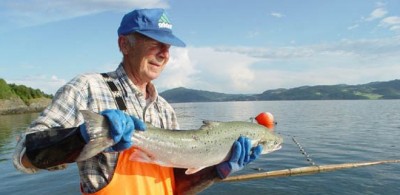Concerns over low wild salmon stocks have prompted state officials to regulate fishing from the end of this week in several rivers and areas along the Norwegian coast. They want to ensure that as many female fish as possible can work their way up the rivers for spawning.

“We are very worried about the situation for wild salmon,” said Heidi Hansen, acting section chief of the Norwegian Environment Agency (Miljødirektoratet). Hansen and her colleagues predict that low catches indicate there won’t be enough spawning fish in Norway’s inland waterways this autumn.
The agency is thus halting fishing at sea with kilenot (wedge-shaped weir) from Friday off the coast of Nordmøre, in the Trondheimsfjord, in Nord-Troms and in Vest-Finnmark. The regulation, which the agency itself calls “extraordinary,” also calls for all female salmon caught in the rivers in the same areas to be released beginning on Saturday. River managers with a fishing season running until August 31 can instead choose to halt all fishing 14 days earlier. Local authorities “must decide which alternative is best,” announced the state agency.
Sharp decline in returning salmon
Their concerns are based on a sharp decline in the stocks of medium- and large-sized salmon swimming in towards the Norwegian coast in July. Salmon catches in the rivers so far this year have in general been lower than last year, despite some regional differences.
“Preliminary evaluations conducted by the Norwegian Institute for Nature Research (Norsk institutt for naturforskning) show alarmingly low catches in some rivers,” reported Hansen on Miljødirektoratet’s own website. “We’re especially worried about the situation in the Trondheimsfjord, where the numbers of salmon heading for rivers like the Gaula and Orkla were also low in 2012.”
She said it therefore was important to help ensure that the most female salmon possible survive for spawning. The agency’s regulation was taken without any public hearings or consultation with the Sametinget (the Sami Parliament in Karasjok).
Still ‘sustainable’
It was hailed by Torfinn Evensen of the organization Norske Lakseelver, which earlier has called for limits on wild salmon fishing both at sea and in the rivers. Vegard Heggem, who offers salmon fishing on the Orkla River at Rennebu, agreed that wild salmon fishing this year has been poor. He claimed, though, that river managers have done what they can to secure stocks.
“We can document that the fishing is sustainable,” Heggem told newspaper Dagens Næringsliv (DN). Managers of both the Orkla and Gaula rivers already ordered that all female salmon caught be released from July 1. The environmental agency’s new regulations will thus have little effect on them.
River owners stand to lose a lot of money from sportsfishing enthusiasts who pay a lot to fish for wild salmon along Norwegian rivers, if the rivers are forced to close entirely. That’s why they prefer catch and release programs instead of outright closure.
Royal release on the Alta River
Among those fishing last week along the Alta River in Vest-Finnmark was King Harald, who reportedly caught five salmon with his fishing party. “That’s not so bad,” Ivar Leinan of the local salmon fishing group Alta Laksefiskeri Interessentskap told DN. “They released four of them and only took one male salmon.” Leinan said the salmon fishing season was winding down in Finnmark anyway, so the new regulation shouldn’t be too onerous.
He and others nonetheless question the looming regulation. The fishing “isn’t as bad as they say,” Leinan told Tromsø newspaper Nordlys. Yngve Nilsen of the Vest-Finnmark hunting and fishing association VJFF, which manages the river Repparfjordelva, was skeptical over the data collected by the agency and the time periods when it was gathered. Egil Liberg of the Lakselv land owners’ group claimed the numbers of fish caught in Lakselva have climbed lately, but after an admittedly poor start to the season.
The number of wild salmon that return from the sea to Norway every year varies from year to year. The numbers have declined considerably since the 1980s, reported the state agency, and have been consistently low the past six years. Wild salmon returning to the rivers is believed to have declined more than 50 percent from the three-year research period of 1983-1986 to the three years from 2009-2012.
Views and News from Norway/Nina Berglund

